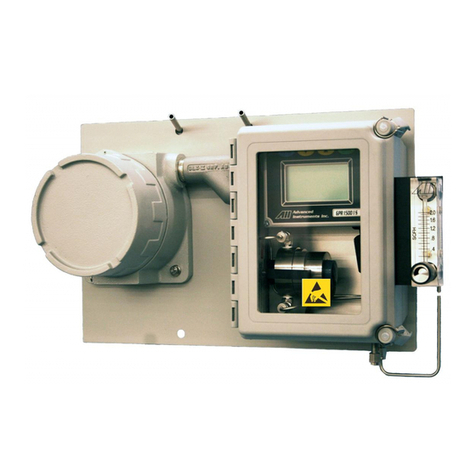
2855
Metropolit
an
Place,
Pomona,
CA
91767
USA
♦Tel: 909-392-6900, Fax: 909-392-3665, www.aii1.com, e-mail: [email protected] Rev 10/15 ISO 9001:2008 Certified
INTERTEK Certificate No. 485
GPR-1500 AIS
PPM Oxygen Analyzer
Full Featured PPM Oxygen Analyzer with
Optional Modbus RTU Communication and
Modular Natural Gas Sample Systems
Technical Specifications *
Accuracy: < 2% of FS range under constant conditions
Analysis: 0-10, 0-100, 0-1000 PPM, 0-1%, 0-25% (CAL) FS
Auto-ranging or manual lock on a single range
Application: Oxygen analysis in inert, hydrocarbon, helium, hydro-
gen, mixed and acid (CO2) gas streams
Approvals: Certified for use in hazardous areas - see lower right
UL: United States: UL 1203, UL 913, UL 508
Canada: CAN/CSA C22.2 No. 30-M1986,
CAN/CSA C22.2 No. 157-92,
CAN/CSA C22.2 No. 14-10
ATEX: Directive 94/9/EC
Area Classification: Certified for use in hazardous areas - see lower right
Alarms: Two user configurable alarms: magnetic coil relays
rated 3A at 100 VAC, programmable alarm delays,
alarm bypass for calibration and system fail alarm
Calibration: Max interval—3 months. Use certified span gas with
O2 content (balance N2) approximating 80% of full
scale for fast 20-30 minute recovery to online use.
Alternatively, air calibrate with clean source of com-
pressed or ambient (20.9% O2) air on 0-25% range
and allow 60 minutes on zero gas to recover to 10
ppm. For optimum accuracy, calibrate one range high-
er than the range of interest.
Compensation: Barometric pressure and temperature (ATEX)
Temperature (UL)
Connections: 1/8" compression tube fittings
Controls: Water resistant keypad; menu driven range selection,
calibration and system functions
Display: Graphical LCD 2.75” x 1.375”; resolution 0.01 PPM;
displays real time ambient temperature and pressure
Enclosure: NEMA Type 3R for rain in outdoor applications (UL)
NEMA 4X (ATEX)
Flow: Not flow sensitive; recommended flow rate 1-2 SCFH
Linearity: ±2% of full scale
Pressure: Inlet - regulate to 5-30 psig to deliver 1-2 SCFH flow;
vent - atmospheric
Power: 12-28 VDC (cUL and ATEX Certified)
110-220 VAC (ATEX Certified)
Response Time: 90% of final reading in 10 seconds
Sample System: Sample flow meter; options available, see other side
Sensitivity: < 0.5% of FS range
Sensor Model: XLT-12-333 for gases containing > 0.5% CO2
Sensor Life: 24 months in < 1000 PPM O2 at 25ºC and 1 atm
Signal Output: 4-20mA non-isolated or 1-5V; optional Modbus RTU
communication
Operating Range: 5ºto 45ºC (GPR sensor); -10ºC to 45ºC (XLT sensor)
Warranty: 12 months analyzer; 12 months sensor
Wetted Parts: Stainless steel
Optional Equipment
Sample conditioning systems (see back page) - Contact factory
GPR-12-333 sensor for non-acid (CO2) gas streams
* Specifications subject to change without notice
Exia
UL Certified
File E343386
Class I, Division 1, Groups C and D
T4 Tamb -20⁰C to +50⁰C
0080
ATEX Certified - Directive 94/9/EC
Examination Cert: INERIS 08ATEX0036
II 2 G
Ex d ib IIB T4 Gb
Tamb -20⁰C to +50⁰C
cUL & ATEX Certified for Hazardous Areas





























